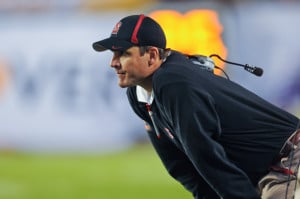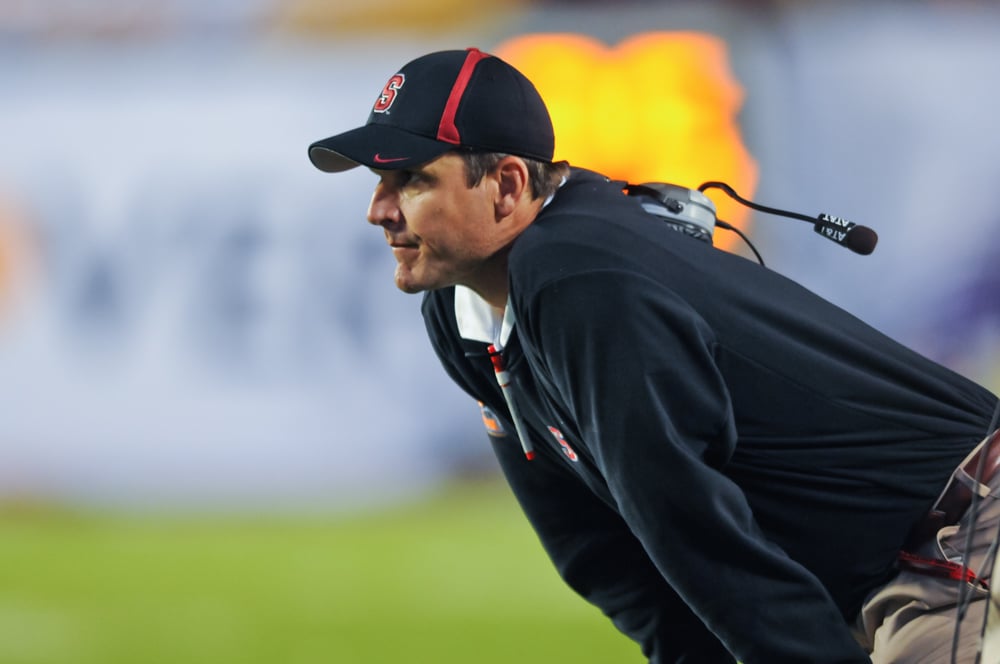When the San Francisco 49ers and Seattle Seahawks clash in this Sunday’s NFC Championship game, it will be another installment in one of the most heated personal rivalries in sports between Jim Harbaugh and Pete Carroll. Though Stanford fans are quick to side with Harbaugh, their former head coach, over Carroll, who was known to run up the score when coaching USC, Harbaugh has often played the part of instigator in their infamous relationship. We asked football writers Winston Shi, David Cohn and Do-Hyoung Park: Pac-12 affiliations aside, which coach is the “good guy” and which is the “bad guy”?

Winston: To be completely honest with you, there really is no answer. Both coaches aren’t perfect. Harbaugh rubbed many people the wrong way. While the “What’s your deal?” blowout announced Stanford’s revival as a football program, few Stanford fans will argue that Harbaugh going for two while up by four touchdowns was a classy move in any way. Though Carroll’s Trojans could run up the score at times, Carroll also knew when to let off the gas, as Notre Dame and Penn State fans will tell you.
Meanwhile, although Carroll himself is popular, USC lost a national championship due to the Reggie Bush scandal. In addition, from Brian Cushing at USC to a number of Seahawks players now, Carroll’s players have shown a certain tendency to skirt the rules, especially regarding PEDs. We don’t know how much Carroll has to do with any of these things, but ultimately his team is his responsibility.
Should our college fandom factor into this assessment? As a rule, the relationship between a coach and a school is the proverbial two-way street. Harbaugh deserves a huge share of the credit for rebuilding the Stanford football program, but in the end he viewed Stanford as a stepping-stone to his true dream: the NFL. Carroll left USC once it was clear that NCAA sanctions were about to hamstring his program. This is not to say that Stanford should not be grateful to Harbaugh, or USC to Carroll—but our university allegiances shouldn’t really factor into our perceptions of good and evil.
Coaching football is a job, and when it comes to our relationships with former college coaches, as with Harbaugh and Carroll, it’s ultimately just business when they come and go. Even if Richard Sherman’s much-publicized beef with his former coach happens to add some color to the narrative, whatever animosity may exist between the two is ultimately a personal affair. It’s not our duty to determine which one has the moral high ground.
David: I know that, as a Cardinal fan, I am seemingly obligated to select Coach Harbaugh as the “good guy.” I mean, how can I not support a guy who clearly has such good taste in television shows? In all seriousness though, I think that both coaches have certainly had their “bad guy” moments.
In Jim Harbaugh’s case, the instruction from Harbaugh and Defensive Coordinator Vic Fangio to Chase Thomas ’12 to fake an injury in the 2010 Oregon game was a pretty infamous moment that did not reflect well on the Stanford program. In particular, that incident put Stanford in inglorious company with Cal as two Pac-12 programs that resorted to dubious tactics in order to challenge the Ducks.
In addition, once Harbaugh reached the NFL, he made a point to endear himself to his colleague Jim Schwartz in their infamous 2011 post-game handshake. While I believe that Schwartz was certainly at fault for his emotional outburst in response to Harbaugh’s “bro back tap,” Harbaugh could have very easily maintained some semblance of professionalism at that moment.
On the other hand, Carroll is also not immune from angering people. In particular, the fallout from the Reggie Bush fiasco, which resulted in Carroll’s flight to the NFL right before the NCAA imposed harsh sanctions on USC and crippled his once proud-program, hurt Carroll’s image.
Carroll has also drawn additional criticism for the fact that numerous Seahawks players have tested positive for performance-enhancing drugs on his watch. These Seahawks include cornerbacks Brandon Browner and Walter Thurmond, defensive end Bruce Irvin, guard John Moffitt, offensive lineman Allen Barbre and safety Winston Guy.
In both cases, it appears to me that Carroll is either extremely naive, completely incapable of maintaining “institutional control” with regards to the multiple programs that he has led, or he is condoning this behavior by his inaction. I wonder which one it could be?
In the end, regardless of my thoughts on Carroll and Harbaugh, I completely agree with Winston that we will certainly be entertained by the great storylines that have come to define one of the best rivalries in the NFL. Sunday’s NFC Championship game figures to make for great theatre, and I fully expect that the viewing audience will be thoroughly entertained.
Do: Reader, let me take you on a journey.
Imagine that the Pac-10 conference of the late 2000’s is an idyllic cul-de-sac buried deep in the suburbs of Nowhereville, Calif. Looking at the scene, you can’t help but feel that the unifying factor of the picture, the “I,” so to say, is the sturdy, robust cardinal-and-gold house on the far side. It has a historic, powerful aura about it, and even the very houses around it seem to acknowledge its splendor, appearing almost as supporting characters in the grand scheme of the neighborhood. To outsiders, that house is the very representation of the neighborhood as a whole.
On the front lawn struts a dignified, regal mastiff. Reader, meet Pete Carroll.
Hidden in the splendid grandeur of the central house, easily passed over as an afterthought in the grand planning of the neighborhood, lies a small, tattered, broken, bruised outhouse. On one of its walls, one can just barely make out the faint outline of a tree — albeit a strange tree, with eyes, legs and what looks to be a human inside it. The owners are considering selling the outhouse but are reluctant to do so because of its once-proud history.
One day, a chihuahua appears. Nobody knows where he came from — rumor has it that he once lived in San Diego — but he immediately takes the neighborhood by storm. He treads freely on the other dogs’ territory. He yips to the left, yaps to the right, urinates on everything that moves and seemingly has no sense of shame. He seems to make his home in the outhouse, and because of that, nobody really takes him seriously. That’s right — enter Jim Harbaugh.
Little Jimmy packs a lot of spunk into his little frame. He immediately takes to openly challenging Pete’s authority. “I bow to no dog,” Jimmy said defiantly. He begins to chip away at the very pillars of the grand house, gnawing away at them with his teeth. It doesn’t seem as if he is making much progress, and the neighborhood writes him off as “that crazy new dog.”
But Jimmy persists. He continues on. He recruits a small army of the squirrels, raccoons and pests of the neighborhood to help his cause. On Oct. 6, 2007, with the help of a ferret known only as “Tavita,” a pillar of the house falls. Pete watches in horror. Outsiders take notice of the feisty Jimmy.
Fast-forward two years. Jimmy has made a noticeable dent in the house, helped in part by a rather portly greyhound known as “Chip.” Jimmy is relentless. His squirrels, raccoons and pests are bigger, better, faster, stronger. Pete is horrified. He has done nothing to disturb Jimmy, yet Jimmy has done nothing but disturb the natural order of the neighborhood since he first moved in. Pete doesn’t understand. All he wanted was to continue being comfortable as leader of the previously peaceful neighborhood. Pete is worried for his house, which is starting to show the stresses of Jimmy’s assaults.
Finally, the house falls. Jimmy unleashes a raccoon named “Toby” to wreak havoc on the aged walls and ancient facades of the house, and the house crumbles with Pete watching helplessly. To add insult to injury, Jimmy jumps all over the skeleton of the ruined house with an almost rabid fervor until every last board is splintered, every last pane of glass shattered. He then immediately proceeds to push the outhouse into the middle of the rubble and firmly plant its foundation.
After the dust settles, an aghast Pete can only muster, “What’s your deal?”
With a grin, Jimmy answers, “What’s your deal?”
So, reader, you decide. Who’s the good guy and who’s the bad guy here?
David Cohn and Winston Shi are too concerned about their reputations to fully take advantage of such a delightful prompt. Do-Hyoung Park, on the other hand, knows that ship sailed long ago. Let David, Winston and Do know who you side with at dmcohn ‘at’ stanford.edu, wshi94 ‘at’ stanford.edu and dpark027 ‘at’ stanford.edu, respectively.
